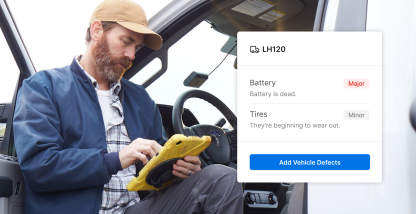Fuel consumption accounts for up to 60% of operating costs in a company’s total fleet budget. By reducing your fuel consumption, you can improve your bottom line.
Companies are using fleet management systems and fleet fuel tax apps to improve fuel efficiency. Fleet management systems help track, optimize, and manage the fleet’s fuel usage. Fleet fuel tax apps are perfect for monitoring fuel purchase data and fuel tax submissions.
Continue reading to learn more fuel-saving tips for drivers and fleet owners.
How to save fuel as a driver
Below are several ways commercial drivers can cut fuel consumption and save on fuel costs.
Monitor tire pressure
Ensuring your tires aren’t overinflated or underinflated can help you save on fuel costs and other expenses.
It’s a good practice to maintain proper tire inflation based on the vehicle manufacturer’s recommendations. It’s also a good idea to perform routine maintenance checks to ensure safety and better fuel economy.
Be careful to avoid overinflating tires. Extra air pressure can distort your tire’s shape. It can also lead to lower traction and more wear and tear down the tire’s center. Overinflation can also cause tires to wear out more quickly, adding to repair and maintenance costs.
Underinflated tires can increase the vehicle’s drag. By working harder, the vehicle consumes more fuel and increases the likelihood of tread separation and tire blowouts. And that can cause accidents.
According to the U.S. Department of Energy, you can improve gas mileage from 0.6% to up to 3% by keeping your vehicle’s tires properly inflated.
Drive steadily
Avoid fuel-wasting driving practices,. Even methods like varying your speed between 75 and 85 km per hour every 18 seconds can increase your fuel use by 20%.
Use cruise control when driving on highways. It’s good to know that slight speed variations can be beneficial when going downhill, and gravity can do most of the work. You can drop your speed during uphill travels, then regain time going downhill.
Ensure your vehicle is aerodynamic
Ensuring good aerodynamics for your vehicle can reduce drag and improve fuel efficiency, especially at high speeds.
Closing your windows and sunroof on the freeway, even keeping your vehicle’s exterior clean, can reduce drag and improve fuel efficiency.
Keeping your vehicle aerodynamically sound is also helpful when specifying your vehicle for fuel mileage and improving fuel efficiency.
Check traffic conditions
Look up the traffic conditions along your route before taking off. It will help you avoid heavy traffic that can lengthen idling time and increase your fuel consumption.
Follow these tips to save fuel.
- Map out your route, especially for long trips.
- Avoid roads that cut through known congestion sites. These are usually dotted with intersections, pedestrians, and stoplights and/or busy during rush hours.
- Listen to traffic reports and avoid locations where accidents have taken place or there’s road construction.
Look ahead while driving. Keep a proper distance between your vehicle and those in front. Knowing what other cars and pedestrians are doing allows you to anticipate their next move. This helps you keep your speed steady and use less fuel.
Checking and actively watching traffic conditions can also improve your safety while driving.
How to conserve gas when running low
It’s challenging to keep your vehicle running when your tank is nearly empty. Fortunately, there are fuel-saving tips you can follow to conserve gas and keep your vehicle running to the next gas station.
Turn off the AC
Switching off your air conditioner or heater can help reduce your fuel consumption by 25%. It can be challenging during summer or winter. Even so, sweating or feeling cold for a few minutes beats running out of fuel and getting stuck in the same conditions for hours.
Reduce your speed
It can be tempting to speed up to get to the closest gas station quickly. Remember, though, the faster you go, the more fuel your vehicle uses.
Close the windows
Save gas by closing your vehicle’s windows. When traveling at high speeds, wind resistance is improved when the windows are rolled up. An open window can reduce your vehicle’s aerodynamics, creating air resistance that leads to more fuel consumption.
How to save fuel as a fleet manager
Fleet managers play a crucial role in optimizing fuel consumption and increasing fuel efficiency.
Below are tips that fleet managers can use to save fuel.
Optimize routes
Electronic logging devices, or ELDs, include GPS tracking features you can use to help decrease fuel consumption and increase route management efficiency.
Efficient route management ensures that drivers are taking the shortest or most efficient route to their destination. And efficient routing positively impacts the amount of fuel vehicles consume. Fleet managers can use GPS tracking to identify the shortest and least congested routes.
Proper fleet management allows you to consolidate trips and ensure drivers aren’t making unnecessary trips that consume more fuel than necessary.
Real-time fleet asset management and vehicle monitoring can also help lessen unapproved route deviations.
Reduce idling
Vehicle idling happens when a vehicle is left running while stopped. Even a still vehicle can increase fuel consumption.
Trucks that consume $70,000 of fuel per year are estimated to spend an average of $5,600 on idling.
If you’re managing 100 commercial vehicles, you’d be wasting a total of $560,000 every year due to vehicle idling. That’s more than half a million dollars you can easily save by monitoring vehicles and ensuring commercial drivers cut down on idling.
The Motive fleet management solution has an idle-time tracking feature that lets fleet managers identify and train drivers who engage in excessive idling.
You can also use truck tracking to reduce fuel costs. This allows you to identify drivers who idle for too long or too frequently. Truck tracking even lets you compare drivers’ performances across different terminals.
Invest in fuel efficiency solutions
A robust fuel efficiency solution can give you a consolidated view of your fleet’s fuel consumption. It can help you easily identify which drivers and driving behaviors lead to high fuel consumption. That means you can understand which vehicles are fuel guzzlers.
Some fuel maintenance solutions have artificial intelligence (AI) features that can automatically detect driver behaviors that cause unnecessarily waste fuel.
How Motive can help improve fuel efficiency
The Motive fleet management solution is packed with features such as idle-time tracking, vehicle diagnostics, and GPS tracking. All these features play crucial roles in minimizing fuel-related expenditures.
Request a free demo of the Motive fleet management solution and see how it can help you bring down your fuel costs every month. Call 844-325-9230 if you have any questions.







